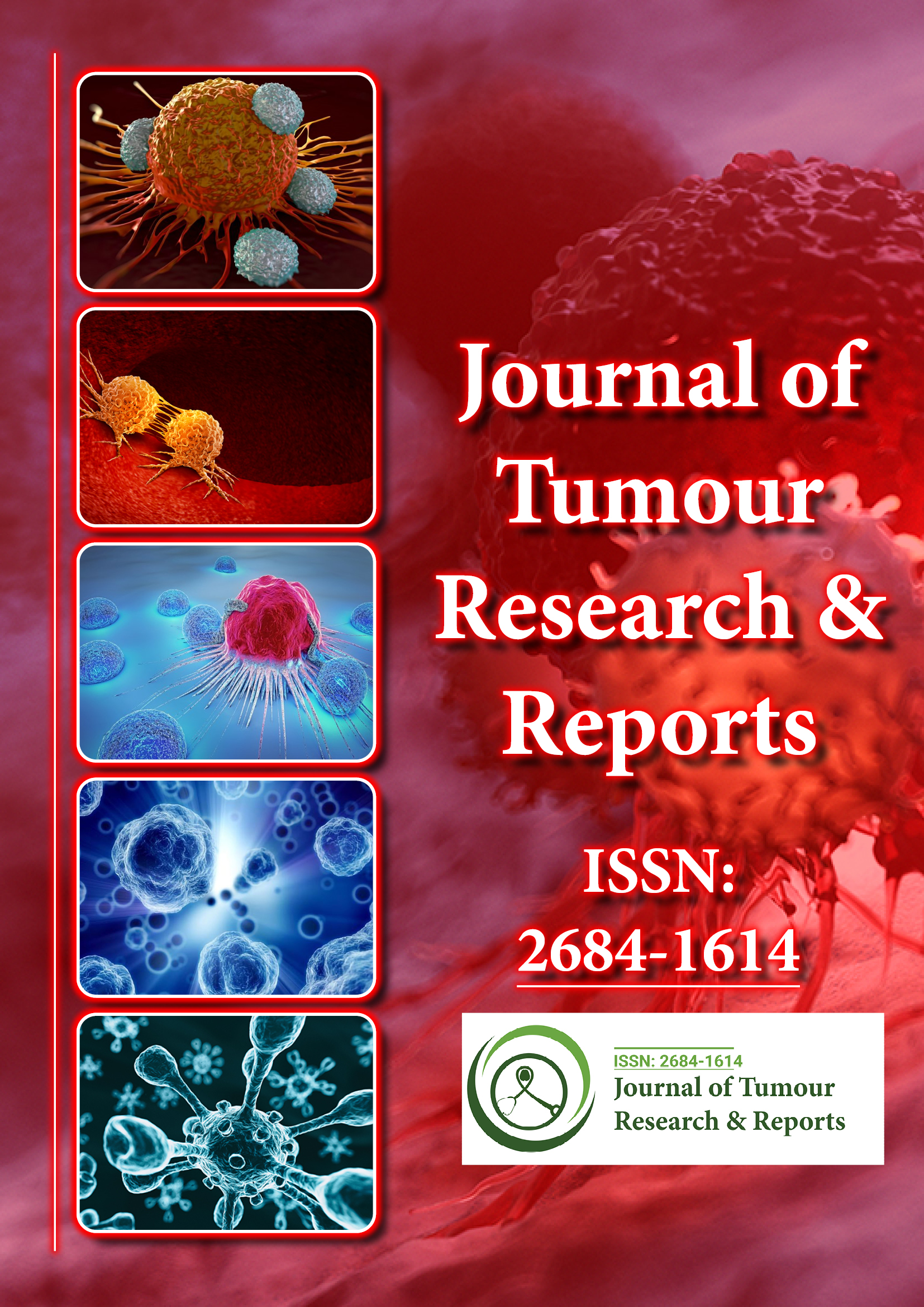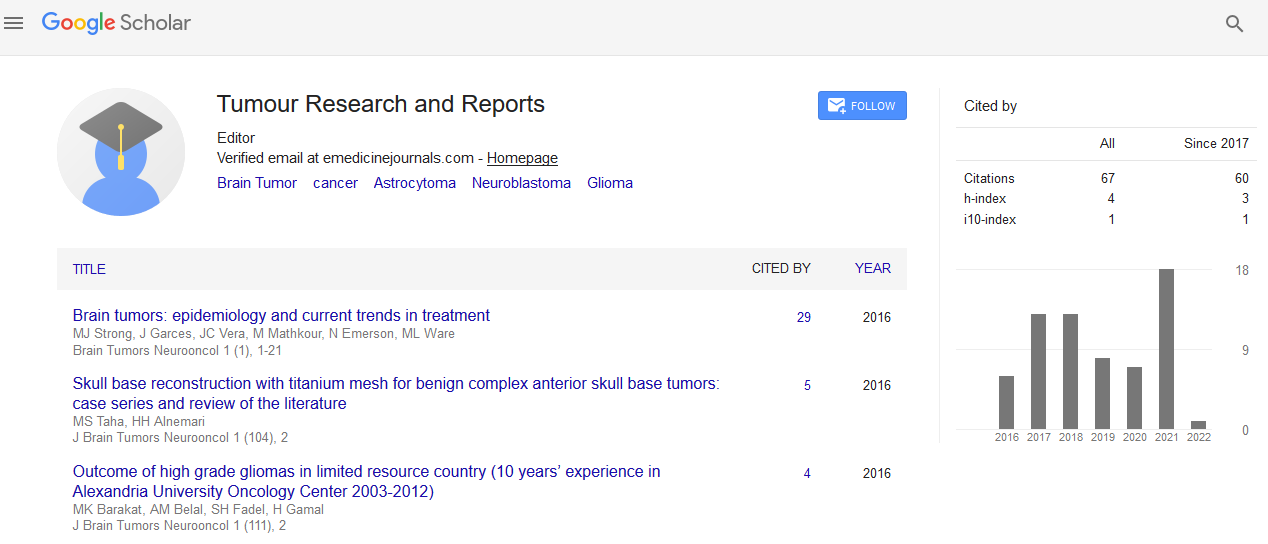Indexed In
- RefSeek
- Hamdard University
- EBSCO A-Z
- Google Scholar
Useful Links
Share This Page
Journal Flyer

Open Access Journals
- Agri and Aquaculture
- Biochemistry
- Bioinformatics & Systems Biology
- Business & Management
- Chemistry
- Clinical Sciences
- Engineering
- Food & Nutrition
- General Science
- Genetics & Molecular Biology
- Immunology & Microbiology
- Medical Sciences
- Neuroscience & Psychology
- Nursing & Health Care
- Pharmaceutical Sciences
Opinion Article - (2025) Volume 10, Issue 2
Tumour Heterogeneity: Diversity Within Malignancy
Elena Rossi*Received: 30-May-2025, Manuscript No. JTRR-25-29823; Editor assigned: 02-Jun-2025, Pre QC No. JTRR-25-29823 (PQ); Reviewed: 16-Jun-2025, QC No. JTRR-25-29823; Revised: 23-Jun-2025, Manuscript No. JTRR-25-29823 (R); Published: 30-Jun-2025, DOI: 10.35248/2684-1614.25.10.262
Description
Tumours are not uniform masses of identical cells but dynamic ecosystems that evolve through time and space. This phenomenon, known as tumour heterogeneity, complicates almost every aspect of oncology, including diagnosis, prognosis, and therapeutic decision-making. Differences can be observed not only between patients, but also between tumours in the same individual, and even among cells that make up a single tumour. These variations arise from genetic mutations, epigenetic alterations, and influences of the tumour microenvironment, which together generate diversity. While such diversity equips tumours with adaptability and resilience against therapy, it also presents unique vulnerabilities that can be exploited in the clinic. Tumour heterogeneity therefore represents both a challenge and an opportunity in the fight against cancer.
Variation between tumours in different patients, referred to as intertumour heterogeneity, forms the basis of personalized medicine. Cancers of the same organ often display entirely distinct behaviours depending on their molecular characteristics. For example, breast cancer can be divided into subtypes such as HER2-positive, hormone receptor-positive, and triple-negative, each with distinct biology and drug response patterns. Similarly, lung cancer patients whose tumours are driven by EGFR mutations or ALK rearrangements respond well to targeted therapies, while those without these alterations do not. The recognition of these differences has transformed treatment paradigms, with targeted therapies and precision medicine significantly improving survival in subsets of patients. Nevertheless, challenges remain in extending these benefits to all patients, as many tumours still lack actionable targets, and resistance often develops even when treatments are initially effective.
Diversity is not limited to differences between patients. Within a single tumour, multiple subpopulations of cells, known as subclones, can coexist. This phenomenon, called intratumour heterogeneity, arises as tumours accumulate mutations and undergo evolutionary pressures. These subclones may compete for dominance, cooperate to promote survival, or remain dormant until selective pressures such as treatment alter the tumour ecosystem. Cancer therapy, whether chemotherapy, targeted drugs, or immunotherapy, functions as a powerful selective force. Sensitive cell populations are eliminated, but resistant clones survive and expand, ultimately driving relapse and progression. This mirrors Darwinian natural selection, with heterogeneity providing the raw material for evolution. The clinical implications are profound, as a single biopsy from one region of a tumour may fail to capture the full complexity of the disease, leading to incomplete or misleading insights about therapeutic vulnerabilities.
Heterogeneity is not only genetic but also spatial and temporal. Spatial heterogeneity refers to differences across various regions of the same tumour or between the primary tumour and metastases. Metastatic sites often display distinct molecular profiles compared to the original tumour, complicating treatment decisions when therapy is based only on the primary lesion. Temporal heterogeneity reflects how tumours evolve over time, particularly under therapeutic pressure. The disease that presents at diagnosis may differ dramatically from the recurrent or metastatic tumour years later, highlighting the necessity of dynamic monitoring rather than relying on a one-time molecular assessment.
Technological advances have provided new tools for understanding and addressing tumour heterogeneity. Liquid biopsies, which analyze circulating tumour DNA or circulating tumour cells in the blood, allow clinicians to sample the tumour’s molecular landscape in a non-invasive and systemic way. Unlike traditional biopsies that represent only a single region of a tumour, liquid biopsies capture contributions from multiple sites, making them valuable for tracking disease evolution. However, interpretation remains challenging, as circulating DNA may represent a mixture of signals from different tumour clones and sites. Single-cell sequencing technologies offer even greater resolution, enabling the characterization of genetic and transcriptomic features of individual cells within a tumour. These methods have revealed extraordinary complexity, including rare subpopulations that play critical roles in resistance and metastasis. Advanced imaging technologies also provide spatial insights, mapping how tumour cells interact with their microenvironment, immune infiltrates, and supporting stromal cells.
Citation: Rossi E (2025). Tumour Heterogeneity: Diversity within Malignancy. J Tum Res Reports. 10:262.
Copyright: © 2025 Rossi E. This is an open-access article distributed under the terms of the Creative Commons Attribution License, which permits unrestricted use, distribution, and reproduction in any medium, provided the original author and source are credited.

